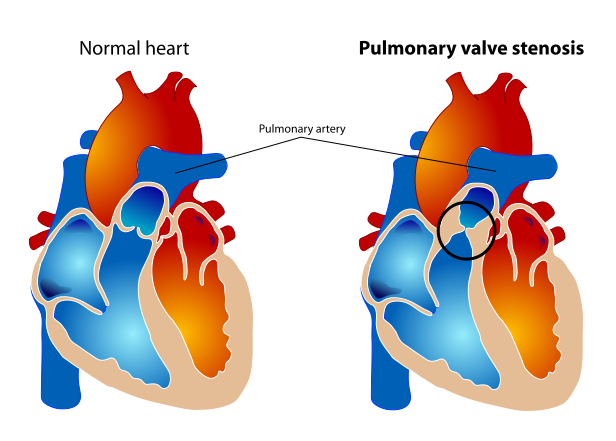Pulmonary valve stenosis (patient information)
For the WikiDoc page for this topic, click here
| Pulmonary valve stenosis (patient information) | |
 | |
|---|---|
| Pulmonary valve stenosis | |
| ICD-10 | I37.0, I37.2, Q22.1 |
| ICD-9 | 424.3, 746.02 |
| OMIM | 265500 |
| DiseasesDB | 11025 |
| MedlinePlus | 001096 |
Editor-In-Chief: C. Michael Gibson, M.S., M.D. [1]; Assistant Editor(s)-In-Chief: Kristin Feeney, B.S. [2]
Overview
Pulmonary valve stenosis is a heart valve disorder that involves the pulmonary valve. This valve separates the right ventricle (one of the chambers in the heart) and the pulmonary artery. The pulmonary artery carries oxygen-poor blood to the lungs. Stenosis occurs when the valve cannot open wide enough. As a result, less blood flows to the lungs.
What are the symptoms of (condition)?
- Abdominal distention
- Bluish coloration to the skin (cyanosis) in some patients
- Chest pain
- Fainting
- Fatigue
- Poor weight gain or failure to thrive in infants with severe blockage
- Shortness of breath
- Sudden death
Note: Patients with mild to moderate blockage may not have any symptoms. There may be no symptoms until the disorder is severe. Symptoms, when present, may get worse with exercise or activity.
Who is at highest risk?
As with any congenital heart disease, patients with a family history of pulmonary valve stenosis are at highest risk.
How to know you have (condition)?
Narrowing in the pulmonary valve is usually present at birth (congenital). It is caused by a problem that occurs when the unborn baby (fetus) is developing. The cause is unknown, but genetics may play a role.Narrowing that occurs in the valve itself is called pulmonary valve stenosis. There may also be narrowing just before or just after the valve. The defect may occur alone or with other congenital heart defects. The condition can be mild or severe. Pulmonary valve stenosis is a rare disorder.
When to seek urgent medical care
Call your health care provider if:
- You have symptoms of pulmonary valve stenosis
- You have been treated or have untreated pulmonary valve stenosis and have developed swelling (of the ankles, legs, or abdomen), difficulty breathing, or other new symptoms
Diagnosis
The health care provider may hear a heart murmur when listening to your heart using a stethoscope. Murmurs are blowing, whooshing, or rasping sounds heard during a heartbeat.
Tests used to diagnose pulmonary stenosis may include:
- Cardiac catheterization
- Chest x-ray
- ECG
- Echocardiogram
- MRI of the heart
Treatment options
Sometimes, treatment may not be needed if the disorder is mild.
When there are also other heart defects, medications may be used to:
- Help blood flow through the heart (prostaglandins)
- Help the heart beat stronger
- Prevent clots (blood thinners)
- Remove excess fluid (water pills)
- Treat abnormal heartbeats and rhythms
Percutaneous balloon pulmonary dilation (valvuloplasty) may be used when no other heart defects are present. This surgery is done through an artery in the groin. The doctor sends a flexible tube (catheter) with a balloon attached to the end up to the heart. The balloon stretches the opening of the valve.
Some patients may need heart surgery to repair or replace the pulmonary valve. The new valve can be made from different materials.
Where to find medical care for (condition)?
Directions to hospitals treating Pulmonary valve stenosis
What to expect (Outook/Prognosis)?
About one-third of patients with mild stenosis get better, one-third stay the same, and one-third get worse. The outcome is good with successful surgery or balloon dilation. Other congenital heart defects may be a factor in the outlook.
Some valves can last for decades. Others wear out and will need to be replaced.
Possible complications
- Cyanosis
- Death
- Heart failure
- Leaking of blood back into the right ventricle (pulmonary regurgitation) after repair
- Right ventricular hypertrophy (enlargement)